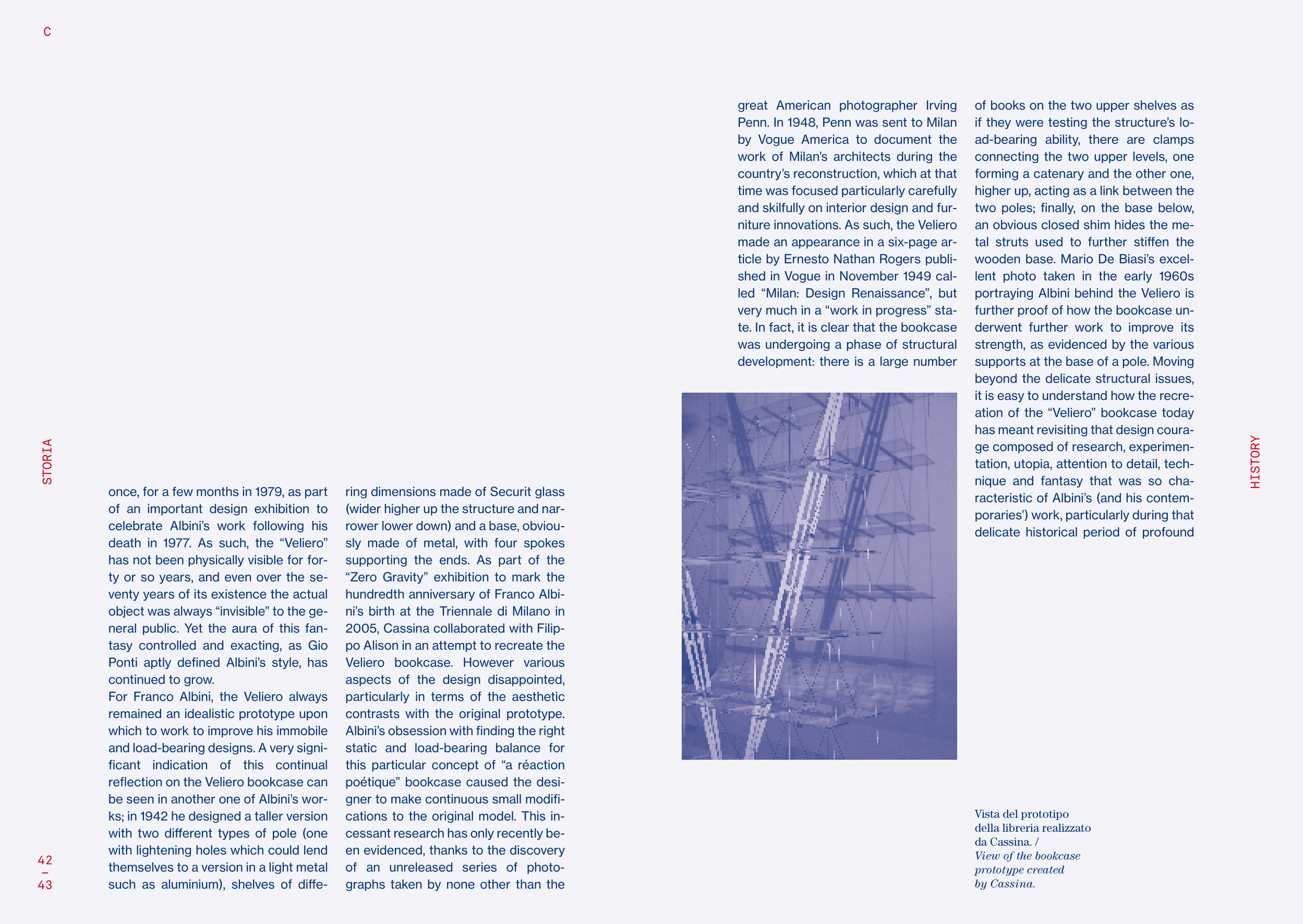STORIA
42
–
43
HISTORY
C
once, for a few months in 1979, as part
of an important design exhibition to
celebrate Albini’s work following his
death in 1977. As such, the “Veliero”
has not been physically visible for for-
ty or so years, and even over the se-
venty years of its existence the actual
object was always “invisible” to the ge-
neral public. Yet the aura of this fan-
tasy controlled and exacting, as Gio
Ponti aptly defined Albini’s style, has
continued to grow.
For Franco Albini, the Veliero always
remained an idealistic prototype upon
which to work to improve his immobile
and load-bearing designs. A very signi-
ficant indication of this continual
reflection on the Veliero bookcase can
be seen in another one of Albini’s wor-
ks; in 1942 he designed a taller version
with two different types of pole (one
with lightening holes which could lend
themselves to a version in a light metal
such as aluminium), shelves of diffe-
ring dimensions made of Securit glass
(wider higher up the structure and nar-
rower lower down) and a base, obviou-
sly made of metal, with four spokes
supporting the ends. As part of the
“Zero Gravity” exhibition to mark the
hundredth anniversary of Franco Albi-
ni’s birth at the Triennale di Milano in
2005, Cassina collaborated with Filip-
po Alison in an attempt to recreate the
Veliero bookcase. However various
aspects of the design disappointed,
particularly in terms of the aesthetic
contrasts with the original prototype.
Albini’s obsession with finding the right
static and load-bearing balance for
this particular concept of “a réaction
poétique” bookcase caused the desi-
gner to make continuous small modifi-
cations to the original model. This in-
cessant research has only recently be-
en evidenced, thanks to the discovery
of an unreleased series of photo-
graphs taken by none other than the
great American photographer Irving
Penn. In 1948, Penn was sent to Milan
by Vogue America to document the
work of Milan’s architects during the
country’s reconstruction, which at that
time was focused particularly carefully
and skilfully on interior design and fur-
niture innovations. As such, the Veliero
made an appearance in a six-page ar-
ticle by Ernesto Nathan Rogers publi-
shed in Vogue in November 1949 cal-
led “Milan: Design Renaissance”, but
very much in a “work in progress” sta-
te. In fact, it is clear that the bookcase
was undergoing a phase of structural
development: there is a large number
of books on the two upper shelves as
if they were testing the structure’s lo-
ad-bearing ability, there are clamps
connecting the two upper levels, one
forming a catenary and the other one,
higher up, acting as a link between the
two poles; finally, on the base below,
an obvious closed shim hides the me-
tal struts used to further stiffen the
wooden base. Mario De Biasi’s excel-
lent photo taken in the early 1960s
portraying Albini behind the Veliero is
further proof of how the bookcase un-
derwent further work to improve its
strength, as evidenced by the various
supports at the base of a pole. Moving
beyond the delicate structural issues,
it is easy to understand how the recre-
ation of the “Veliero” bookcase today
has meant revisiting that design coura-
ge composed of research, experimen-
tation, utopia, attention to detail, tech-
nique and fantasy that was so cha-
racteristic of Albini’s (and his contem-
poraries’) work, particularly during that
delicate historical period of profound
Vista del prototipo
della libreria realizzato
da Cassina. /
View of the bookcase
prototype created
by Cassina.


